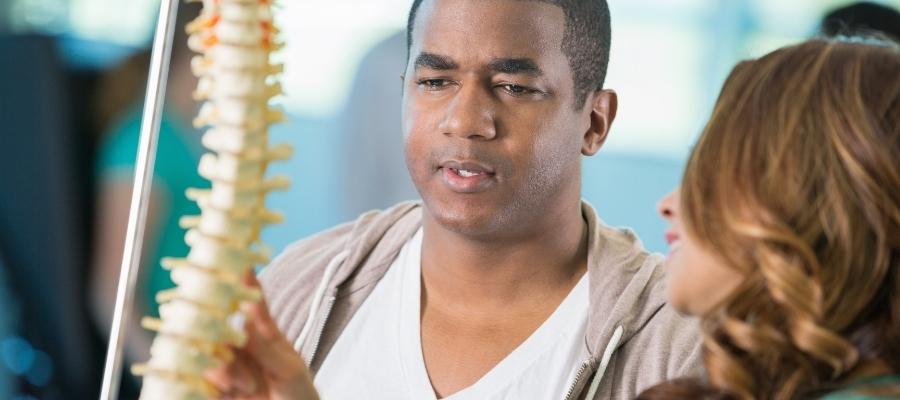Your spine, or backbone, comprises bony vertebrae plus spinal discs, muscles, ligaments, tendons, fluid, and spinal cord. The vertebrae protect your spinal cord and allow you to stand and bend. Several problems can change the spine’s structure or damage the vertebrae and surrounding tissue. Spinal cord injuries (SCI) can result from damage to the vertebrae, ligaments, or disks of the spinal column or to the spinal cord itself. A spinal cord injury is not the same as a back injury. Back injuries may damage bones or soft tissues in the spine, but they do not affect the spinal cord.
Symptoms
The signs and symptoms of common spine conditions and injuries often depend on which spinal nerves are affected. Spine conditions that affect your spinal cord can lead to a wide range of symptoms because your spinal cord carries nerve signals throughout your body. Nerve-related symptoms include:
- Pain, numbness, tingling, or weakness in your arms or legs, depending on the affected nerves
- Loss of coordination, difficulty walking, or climbing stairs
- Loss of bladder or bowel control
Causes
Spine conditions are rare, and the most common cause is traumatic injury. Traumatic spinal cord injuries can stem from a sudden, traumatic blow to your spine that fractures, dislocates, crushes, or compresses one or more of your vertebrae and/or bruises, partially tears, or completely tears the spinal cord.
Most spinal cord injuries are due to preventable causes such as motor vehicle accidents and falls. It can also result from violent encounters, usually from gunshot or knife wounds. Sporting activities such as diving, contact sports, horseback riding, and others cause about 10% of SCI.
Additional damage usually occurs over days or weeks because of bleeding, swelling, inflammation, and fluid accumulation in and around your spinal cord.
A nontraumatic spinal cord injury can be caused by arthritis, osteoporosis, degenerative joint disease, repetitive strenuous activities, improper lifting, cancer, inflammation, infections, or disk degeneration of the spine. Spine conditions can also be present at birth.
Whether the cause is traumatic or nontraumatic, the damage affects the nerve fibres passing through the injured area and can impair part of or all the muscles and nerves below the injury site.
A chest (thoracic) or lower back (lumbar) injury can affect your torso, legs, bowel and bladder control, and sexual function. A neck (cervical) injury affects the same areas and affects movements of your arms and, possibly, your ability to breathe.
Risk factors
Some of the factors that can increase the risk of spine conditions include:
- Genes: Some spinal conditions are inherited disorders such as scoliosis.
- Age: Spinal injuries and back pain become more common with advanced age as the spine structures wear down and degenerate over time.
- Previous spinal injury
- Being overweight or a weak spine or abdominal (core) muscles.
- Using poor form when lifting heavy objects, e.g., lifting with your back instead of your legs.
- Smoking
- History of conditions like arthritis.
- Gender: Spine injuries are most common in young men, likely due to behavioural and occupational factors.
Treatment
Long-term spinal cord injury treatment and care focus on preventing further injury and empowering people with spinal cord injuries to return to an active and productive life.
At Intercare physical rehabilitation hospitals, the rehabilitation team members will begin working with the patient in the early stages of recovery. The team might include but is not limited to a physiotherapist, an occupational therapist, a rehabilitation nurse, a rehabilitation psychologist, a social worker, and a dietitian.
During the initial stages of rehabilitation, therapists usually emphasize maintaining and strengthening muscle function, redeveloping fine motor skills, and learning ways to adapt to day-to-day tasks. Long-term goals of spinal cord injury treatment include:
- Enhancing independence and quality of life.
- Reducing the risk of chronic (ongoing) health conditions.
- Restoring some nerve function in partial injuries.
Sources
Fostering recovery and restoring health
The four physical rehabilitation hospitals feature 36 to 52 beds, ensuring personalised attention and an intimate healing environment. Here, patients work towards regaining their strength, mobility, and independence under our multidisciplinary team of experienced professionals, including general medical practitioners, case managers, physiatrists, nurses, physiotherapists, occupational therapists, speech therapists, psychologists, dieticians and social workers. They all work together to create comprehensive, customised treatment plans.
Recover in an environment that offers best-practice care, facilities and comfort.












